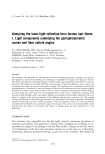j. Cosmet. sci., 54, 301-316 (May/June 2003) Analyzing the laser-light reflection from human hair fibers. I. Light components underlying the goniophotometric curves and fiber cuticle angles F.-J. WORTMANN, DWI, Deutsches Wollforschungsinstitut e. V., Vdtmanplatz 8, 52062 Aachen, Germany, E. SCHULZE zuR WIESCHE, Henkel KGaA, Henkdstrasse 67, 40191 Diissddorf Germany, and A. BIERBAUM, Fiantec GmbH, Technologiezentrum, Europaplatz, 52068 Aachen, Germany. Accepted for publication August 1, 2002. Synopsis The consumer may repeatedly over the day apply intensive grooming procedures to maintain and improve hair appearance. Among these, brushing and combing are responsible for changes if not damage to the hair fiber surface. Beneficial or unfavorable changes to the hair surface may furthermore result from any cosmetic treatment. The analysis of laser-light reflection and scattering of human hair fibers is a direct, quick, and non-destructive method to monitor such surface changes. The application of a laser-based, multichannel goniophotometer is described, by which this analysis is based on the determination of the complete angular distribution of reflected light within a sub-second time interval. Systematic investigations of hairs differing in ethnic origin and color show that the goniophotometric curves can be analyzed by assuming three fractions of reflected light, namely, specularly, diffusely, and internally reflected light. Prominent effects are related to changes of the relative intensities of the different light fractions with hair color. The angular intensity distribution for each of the light fractions is well described by a Gaussian distribution. The angular positions of the peaks and their widths are analyzed. From the systematic shift of the intensity peak for specularly reflected light from its expectation angle, the tilt angle of the cuticle cells on the hair fiber surface is determined. All results are discussed with respect to changes along the hair length and for color differences. INTRODUCTION The consumer may repeatedly over the day apply intensive grooming procedures to maintain and improve hair appearance. Among these, brushing and combing are re- sponsible for changes if not damage to the hair fiber surface. Changes to the hair surface will furthermore result from any procedure carried out on the hair, be it bleaching, weathering, abrasion, permanent-waving, to give just a few examples. The analysis of Address all correspondence to F.-J Wortmann. 301
302 JOURNAL OF COSMETIC SCIENCE light reflection and scattering is potentially a direct, quick, and non-destructive method to monitor such changes to the hair surface. Fundamental investigations of light reflection from hair applied goniophotometry to single or arrays of parallel fibers (1-6). For single fibers this method gives detailed insight into the interaction between light and the fiber surface, and a variety of param- eters can be defined in terms of the properties of specularly and diffusely reflected light. However, inherent large variations between individual hairs, be they of color, size, etc., on the one hand, and the long recording time for standard goniophotometric techniques (approx. 15 min), on the other, prevented a broader application (2,6). For our investigations this limitation of goniophotometry was overcome by adapting a multichannel instrument, developed by Haertl et al. (7), with fast access to the complete angular distribution of reflected light from which the intensity distributions for three different components of reflected light can be determined. For a first, fundamental investigation of the methodology, the angular positions and widths of the various components of reflected light and the cuticle angles derived thereof were determined along the length of hairs differing in color and ethnic origin, in order to better under- stand the connection between hair surface and bulk morphology and light scattering. DETERMINING LIGHT REFLECTANCE FROM HUMAN HAIR FIBERS The measurement of light reflectance and scattering from single human hairs, described in this paper, is based on the determination of the angle-dependent intensity of the light from a green laser (X = 532 nm) reflected from a single fiber. The wavelength was chosen such as to be in that range were the daylight sensitivity of the human eye is at a maximum (8). Figure 1 shows the experimental setup for the investigations. At the center of the setup, a hair (length: 10 cm) is held horizontally in a special holder at a constant tension of 200 mg and under ambient, though stable, room conditions (approx. 22øC, 50% RH). The holder contains up to ten hairs in parallel and allows vertical movements to select a hair and horizontal movements in order to select the position to be studied. Three types of hair were investigated, namely brown and blonde Caucasian, and black Asian hair. Each sample was taken from the head of a female volunteer and exceeded in all cases 20 cm in length. The hairs were shampooed (LES 15%, pH 5.5), rinsed, dried, and stored under ambient conditions until usage. The laser beam (approx. 50 laW) is vertically polarized (see Figure 1) and meets the hair fiber, arranged horizontally, at an incident angle of 40 ø (beam spot size 100 lam). The detection of the reflected light is conducted in the horizontal plane containing the fiber and the incident light beam with an Optical Multi-Channel Analyzer (OMA), described in reference (7). The detector contains 167 windows arranged such that each window covers 1 ø, with an overall range for the recording angle of 6.5 ø to 173.5 ø around the center of light scattering and with respect to the direction of the laser beam. The windows are con- nected to light guides that transform the signals into a rectangular array, where the light intensity distribution is observed by a CCD camera, digitized, and analyzed. The data are corrected for the transmission characteristics of the individual light guides and for
Purchased for the exclusive use of nofirst nolast (unknown) From: SCC Media Library & Resource Center (library.scconline.org)


























































































